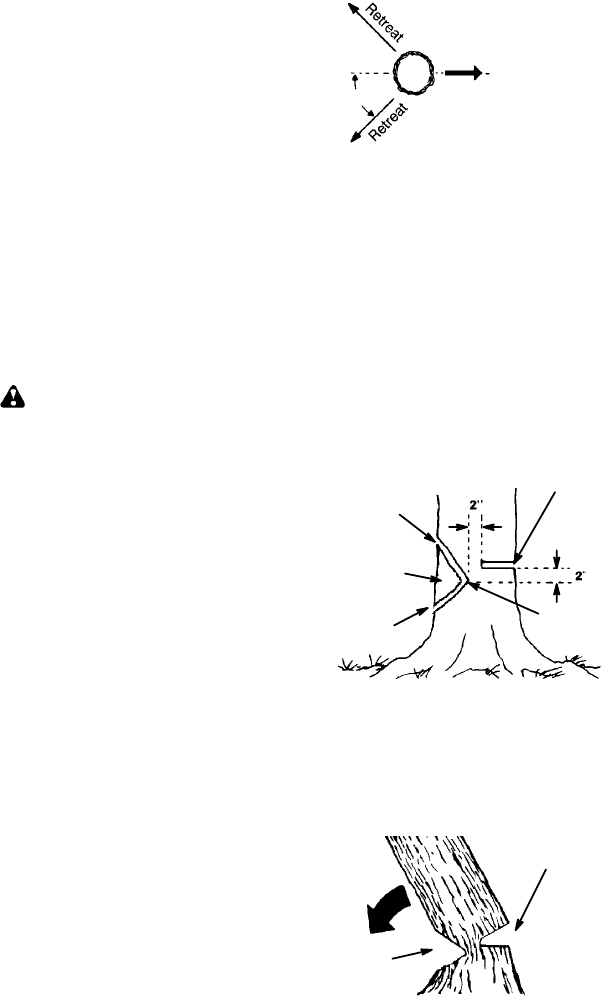
12
S Practice cutting a few small lo gs using the
following techniques to get the“feel” of us-
ing your saw before you begin a major
sawing operation.
S S queeze the throttle trigger and allow the
engine to reach full speed before cutting.
S B egin cutting with the saw frame
against the log.
S K eepthe engine at full speed the entire
time you are cutting.
S A llowthechainto cutforyou. Exertonly
light downward pressure. If you force
the cut,damage tothe bar, chain,or en-
gine can result.
S R elease the throttle trigger as soon as
the cut is completed, allowing the en-
gine to idle. If you run the saw at full
throttle without acutting load,unneces-
sary wear can occur to the chain, bar,
and engine. It is recommended that
the engine not be operated for lon-
ger than 30 seconds at full throttle.
S Toavoidlosingcontrolwhencut iscom-
plete,donotput pr essure onsawat end
of cut.
S Stop the engine before setting the saw
down after cutting.
TREE FELLING TECHNIQUES
WARNING: Check for broken or
dead branches which can fall while cutting
causingserious injury . Do notcut nearbuild-
ings or electricalwires ifyou donot know the
directionof treefall, norcut atnight sinceyou
will not be ale to see well, nor during bad
weather such as rain, snow,or strong winds,
etc. If the tree makes contact with any utility
line, the utility company should be notified
immediately .
S Carefully planyour sawingoperation inad-
vance.
S Cleartheworkarea. Youneeda cleararea
allaroundthe treeso you can havesecure
footing.
S The chain saw operator should keep on
the uphill side of the terrain as the tree i s
likely torollor slidedownhillafter i tis felled.
S Study t he natural co nditio ns th at can cause
the tree to fall in a particular direction.
Natural conditions that can cause a tree to
fall in a particular direction include:
S The wind direction and speed.
S The lean of the tree. The lean of a tree
might not be apparent due to uneven or
sloping terrain. Use aplumb orlevel tode-
termine the direction of tree lean.
S Weight and branches o n one side.
S Surrounding trees and obstacles.
Look for decay and rot. If thetrunk is rotted,
it can snap and fall toward the operator .
Check for broken or dead branches which
can f all on you while cutting.
Make sure there is enough room for the tree to
fall. Maintain a distance of
2-1/2 tree length s
from the nearest person or other objects. En-
gine noise can drown out a warning call.
Remove dirt, stones, loose bark, nails, sta-
ples, andwirefrom thetree wherecuts ar eto
be made.
Plan aclear re treat pathto the rear anddiag-
onal to the line of fall.
Direction of Fall
45_
Plan a clear retreat path
FELLING LARGE TREES
(6 inches (15 cm) in diameter or larger)
The notch method is used to fell large trees.
A notchis cut onthe side ofthe treeinthede-
sired direction of fall. After a felling cut is
made on the opposite side of tree, the tree
will tend to fall into t he notch.
NOTE: If the tree has large buttress roots,
removethem beforemaking thenotch. If u s-
ing saw to remove buttress roots, keep saw
chain fromcontacting groundto preventdull-
ing of the chain.
NOTCH CUT AND FELLING THE
TREE
S Make notch cut by cutting the top of the
notch first. Cut through
1/3 of the diameter
ofthetree. Nextcomplete thenotch bycut-
ting the bottom of the notch. See illustra-
tion. Once the notch is cut remove the
notch of wood from the tree.
Notch
First cut
Second cut
Final (felling) cut here, 2 inches
(5 cm) above center of notch.
Hinge
S After removing the wood from the notch,
make the felling cut on the opposite side of
the n otch.This i s doneby makinga cutabout
two inches (5 cm) higher than the center of
the notch. This will leaveenough uncut wood
between the felling cut and the notch to form
a hinge. This hinge will help prevent the tree
from falling in the wrong direction.
Opening
of felling
cut
Closing of
notch
Hinge holds tree on stump a nd helps
control fall


















